Nike's Sustainability Initiatives: A Comprehensive Case Study Analysis
VerifiedAdded on 2023/06/07
|12
|3101
|464
Case Study
AI Summary
This case study analysis delves into Nike's sustainability initiatives, examining their authenticity and impact on human resources. The study identifies key initiatives, including the integration of the CR department into corporate decision-making and the development of sustainability indexes for manufacturers. It evaluates the authenticity of these initiatives, considering the company's intention to enhance its public image and corporate reputation alongside revenue generation. The analysis also explores the contribution of these initiatives to improving social and human outcomes for employees through better working conditions and sustainability training programs. Furthermore, the study contrasts the potential outcomes of similar initiatives in a different business context, such as a dairy company, highlighting the varying impacts across industries and the challenges faced by smaller enterprises in implementing comprehensive sustainability strategies. The conclusion emphasizes that Nike's sustainability efforts have enhanced its corporate reputation, productivity, supply chain, and stakeholder relationships in the competitive market.
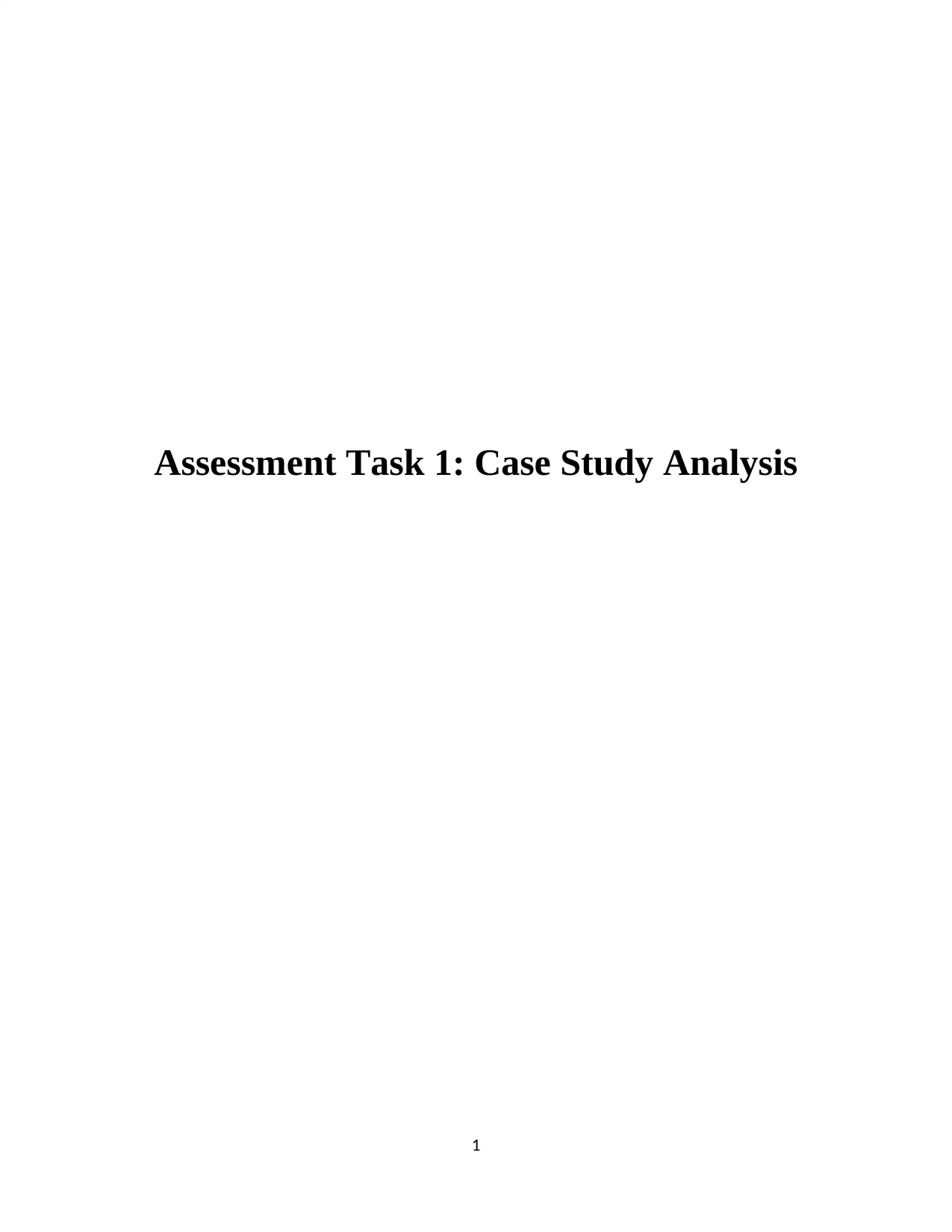
Assessment Task 1: Case Study Analysis
1
1
Paraphrase This Document
Need a fresh take? Get an instant paraphrase of this document with our AI Paraphraser
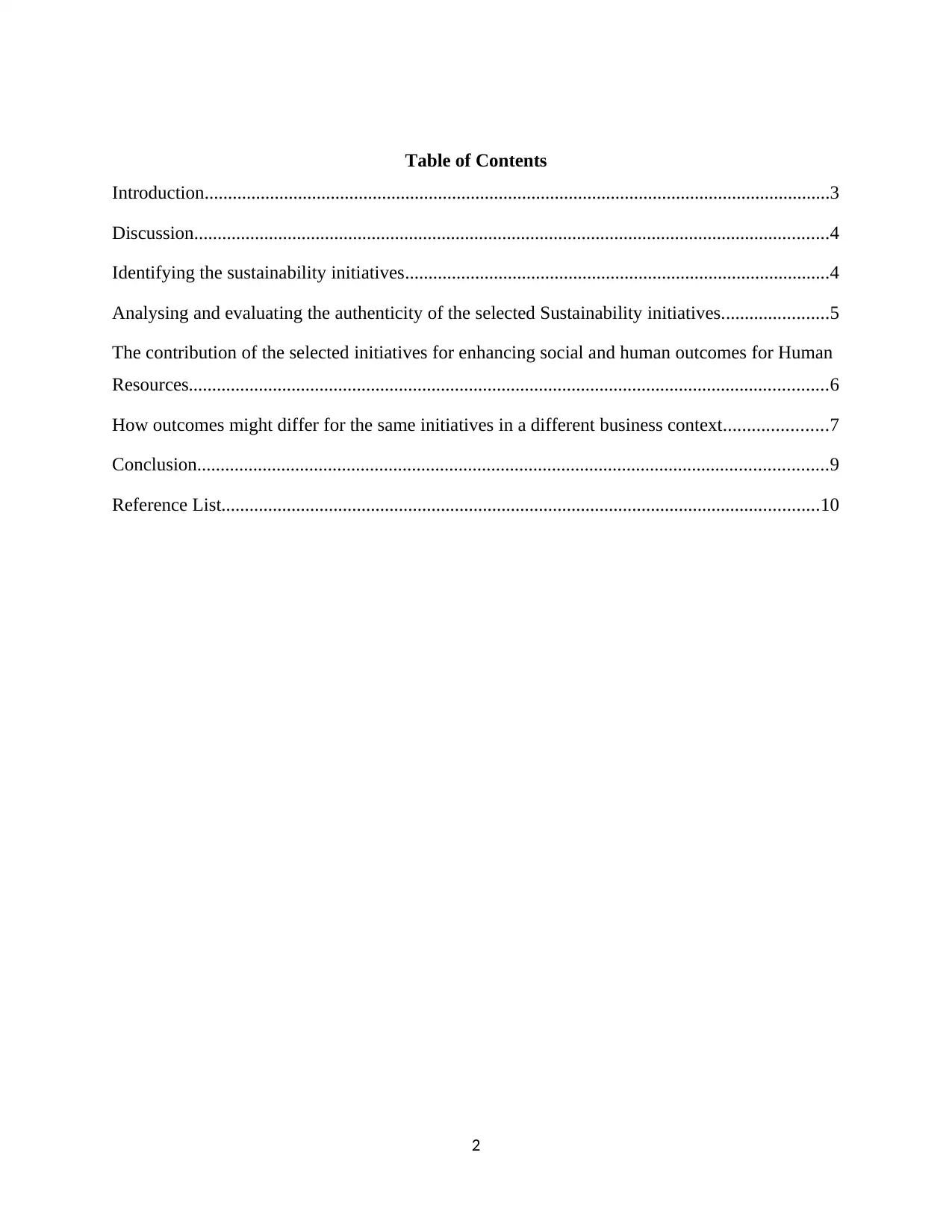
Table of Contents
Introduction......................................................................................................................................3
Discussion........................................................................................................................................4
Identifying the sustainability initiatives...........................................................................................4
Analysing and evaluating the authenticity of the selected Sustainability initiatives.......................5
The contribution of the selected initiatives for enhancing social and human outcomes for Human
Resources.........................................................................................................................................6
How outcomes might differ for the same initiatives in a different business context......................7
Conclusion.......................................................................................................................................9
Reference List................................................................................................................................10
2
Introduction......................................................................................................................................3
Discussion........................................................................................................................................4
Identifying the sustainability initiatives...........................................................................................4
Analysing and evaluating the authenticity of the selected Sustainability initiatives.......................5
The contribution of the selected initiatives for enhancing social and human outcomes for Human
Resources.........................................................................................................................................6
How outcomes might differ for the same initiatives in a different business context......................7
Conclusion.......................................................................................................................................9
Reference List................................................................................................................................10
2
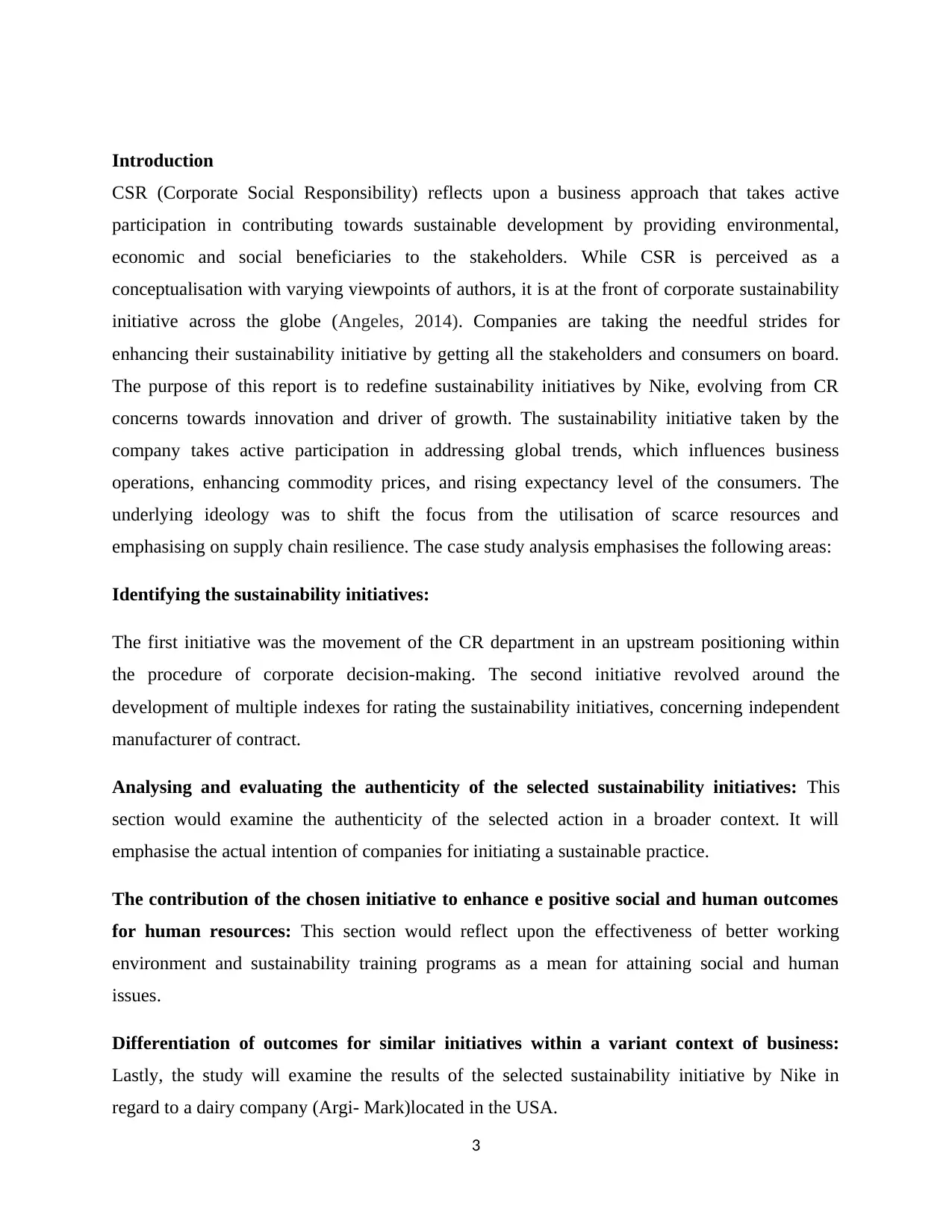
Introduction
CSR (Corporate Social Responsibility) reflects upon a business approach that takes active
participation in contributing towards sustainable development by providing environmental,
economic and social beneficiaries to the stakeholders. While CSR is perceived as a
conceptualisation with varying viewpoints of authors, it is at the front of corporate sustainability
initiative across the globe (Angeles, 2014). Companies are taking the needful strides for
enhancing their sustainability initiative by getting all the stakeholders and consumers on board.
The purpose of this report is to redefine sustainability initiatives by Nike, evolving from CR
concerns towards innovation and driver of growth. The sustainability initiative taken by the
company takes active participation in addressing global trends, which influences business
operations, enhancing commodity prices, and rising expectancy level of the consumers. The
underlying ideology was to shift the focus from the utilisation of scarce resources and
emphasising on supply chain resilience. The case study analysis emphasises the following areas:
Identifying the sustainability initiatives:
The first initiative was the movement of the CR department in an upstream positioning within
the procedure of corporate decision-making. The second initiative revolved around the
development of multiple indexes for rating the sustainability initiatives, concerning independent
manufacturer of contract.
Analysing and evaluating the authenticity of the selected sustainability initiatives: This
section would examine the authenticity of the selected action in a broader context. It will
emphasise the actual intention of companies for initiating a sustainable practice.
The contribution of the chosen initiative to enhance e positive social and human outcomes
for human resources: This section would reflect upon the effectiveness of better working
environment and sustainability training programs as a mean for attaining social and human
issues.
Differentiation of outcomes for similar initiatives within a variant context of business:
Lastly, the study will examine the results of the selected sustainability initiative by Nike in
regard to a dairy company (Argi- Mark)located in the USA.
3
CSR (Corporate Social Responsibility) reflects upon a business approach that takes active
participation in contributing towards sustainable development by providing environmental,
economic and social beneficiaries to the stakeholders. While CSR is perceived as a
conceptualisation with varying viewpoints of authors, it is at the front of corporate sustainability
initiative across the globe (Angeles, 2014). Companies are taking the needful strides for
enhancing their sustainability initiative by getting all the stakeholders and consumers on board.
The purpose of this report is to redefine sustainability initiatives by Nike, evolving from CR
concerns towards innovation and driver of growth. The sustainability initiative taken by the
company takes active participation in addressing global trends, which influences business
operations, enhancing commodity prices, and rising expectancy level of the consumers. The
underlying ideology was to shift the focus from the utilisation of scarce resources and
emphasising on supply chain resilience. The case study analysis emphasises the following areas:
Identifying the sustainability initiatives:
The first initiative was the movement of the CR department in an upstream positioning within
the procedure of corporate decision-making. The second initiative revolved around the
development of multiple indexes for rating the sustainability initiatives, concerning independent
manufacturer of contract.
Analysing and evaluating the authenticity of the selected sustainability initiatives: This
section would examine the authenticity of the selected action in a broader context. It will
emphasise the actual intention of companies for initiating a sustainable practice.
The contribution of the chosen initiative to enhance e positive social and human outcomes
for human resources: This section would reflect upon the effectiveness of better working
environment and sustainability training programs as a mean for attaining social and human
issues.
Differentiation of outcomes for similar initiatives within a variant context of business:
Lastly, the study will examine the results of the selected sustainability initiative by Nike in
regard to a dairy company (Argi- Mark)located in the USA.
3
⊘ This is a preview!⊘
Do you want full access?
Subscribe today to unlock all pages.

Trusted by 1+ million students worldwide
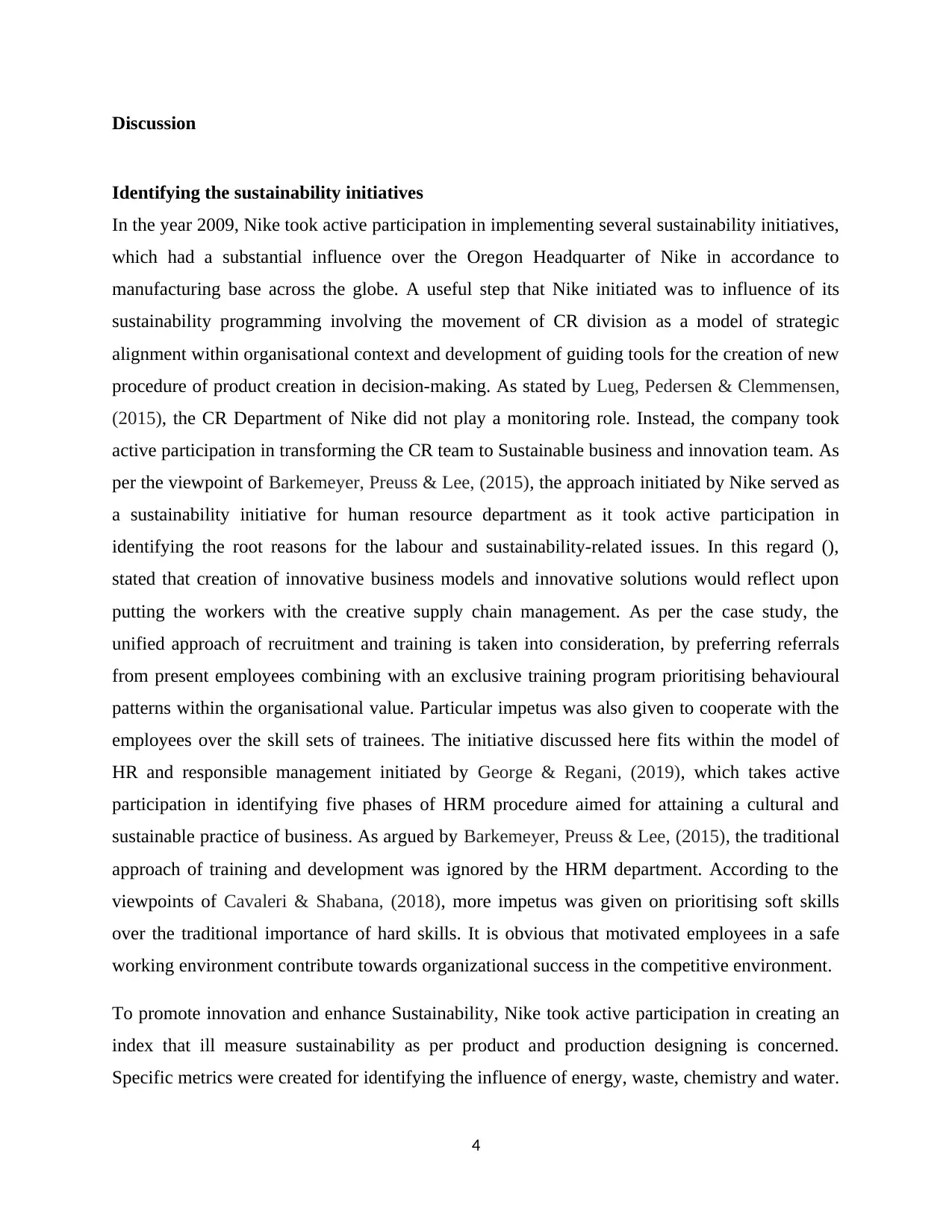
Discussion
Identifying the sustainability initiatives
In the year 2009, Nike took active participation in implementing several sustainability initiatives,
which had a substantial influence over the Oregon Headquarter of Nike in accordance to
manufacturing base across the globe. A useful step that Nike initiated was to influence of its
sustainability programming involving the movement of CR division as a model of strategic
alignment within organisational context and development of guiding tools for the creation of new
procedure of product creation in decision-making. As stated by Lueg, Pedersen & Clemmensen,
(2015), the CR Department of Nike did not play a monitoring role. Instead, the company took
active participation in transforming the CR team to Sustainable business and innovation team. As
per the viewpoint of Barkemeyer, Preuss & Lee, (2015), the approach initiated by Nike served as
a sustainability initiative for human resource department as it took active participation in
identifying the root reasons for the labour and sustainability-related issues. In this regard (),
stated that creation of innovative business models and innovative solutions would reflect upon
putting the workers with the creative supply chain management. As per the case study, the
unified approach of recruitment and training is taken into consideration, by preferring referrals
from present employees combining with an exclusive training program prioritising behavioural
patterns within the organisational value. Particular impetus was also given to cooperate with the
employees over the skill sets of trainees. The initiative discussed here fits within the model of
HR and responsible management initiated by George & Regani, (2019), which takes active
participation in identifying five phases of HRM procedure aimed for attaining a cultural and
sustainable practice of business. As argued by Barkemeyer, Preuss & Lee, (2015), the traditional
approach of training and development was ignored by the HRM department. According to the
viewpoints of Cavaleri & Shabana, (2018), more impetus was given on prioritising soft skills
over the traditional importance of hard skills. It is obvious that motivated employees in a safe
working environment contribute towards organizational success in the competitive environment.
To promote innovation and enhance Sustainability, Nike took active participation in creating an
index that ill measure sustainability as per product and production designing is concerned.
Specific metrics were created for identifying the influence of energy, waste, chemistry and water.
4
Identifying the sustainability initiatives
In the year 2009, Nike took active participation in implementing several sustainability initiatives,
which had a substantial influence over the Oregon Headquarter of Nike in accordance to
manufacturing base across the globe. A useful step that Nike initiated was to influence of its
sustainability programming involving the movement of CR division as a model of strategic
alignment within organisational context and development of guiding tools for the creation of new
procedure of product creation in decision-making. As stated by Lueg, Pedersen & Clemmensen,
(2015), the CR Department of Nike did not play a monitoring role. Instead, the company took
active participation in transforming the CR team to Sustainable business and innovation team. As
per the viewpoint of Barkemeyer, Preuss & Lee, (2015), the approach initiated by Nike served as
a sustainability initiative for human resource department as it took active participation in
identifying the root reasons for the labour and sustainability-related issues. In this regard (),
stated that creation of innovative business models and innovative solutions would reflect upon
putting the workers with the creative supply chain management. As per the case study, the
unified approach of recruitment and training is taken into consideration, by preferring referrals
from present employees combining with an exclusive training program prioritising behavioural
patterns within the organisational value. Particular impetus was also given to cooperate with the
employees over the skill sets of trainees. The initiative discussed here fits within the model of
HR and responsible management initiated by George & Regani, (2019), which takes active
participation in identifying five phases of HRM procedure aimed for attaining a cultural and
sustainable practice of business. As argued by Barkemeyer, Preuss & Lee, (2015), the traditional
approach of training and development was ignored by the HRM department. According to the
viewpoints of Cavaleri & Shabana, (2018), more impetus was given on prioritising soft skills
over the traditional importance of hard skills. It is obvious that motivated employees in a safe
working environment contribute towards organizational success in the competitive environment.
To promote innovation and enhance Sustainability, Nike took active participation in creating an
index that ill measure sustainability as per product and production designing is concerned.
Specific metrics were created for identifying the influence of energy, waste, chemistry and water.
4
Paraphrase This Document
Need a fresh take? Get an instant paraphrase of this document with our AI Paraphraser
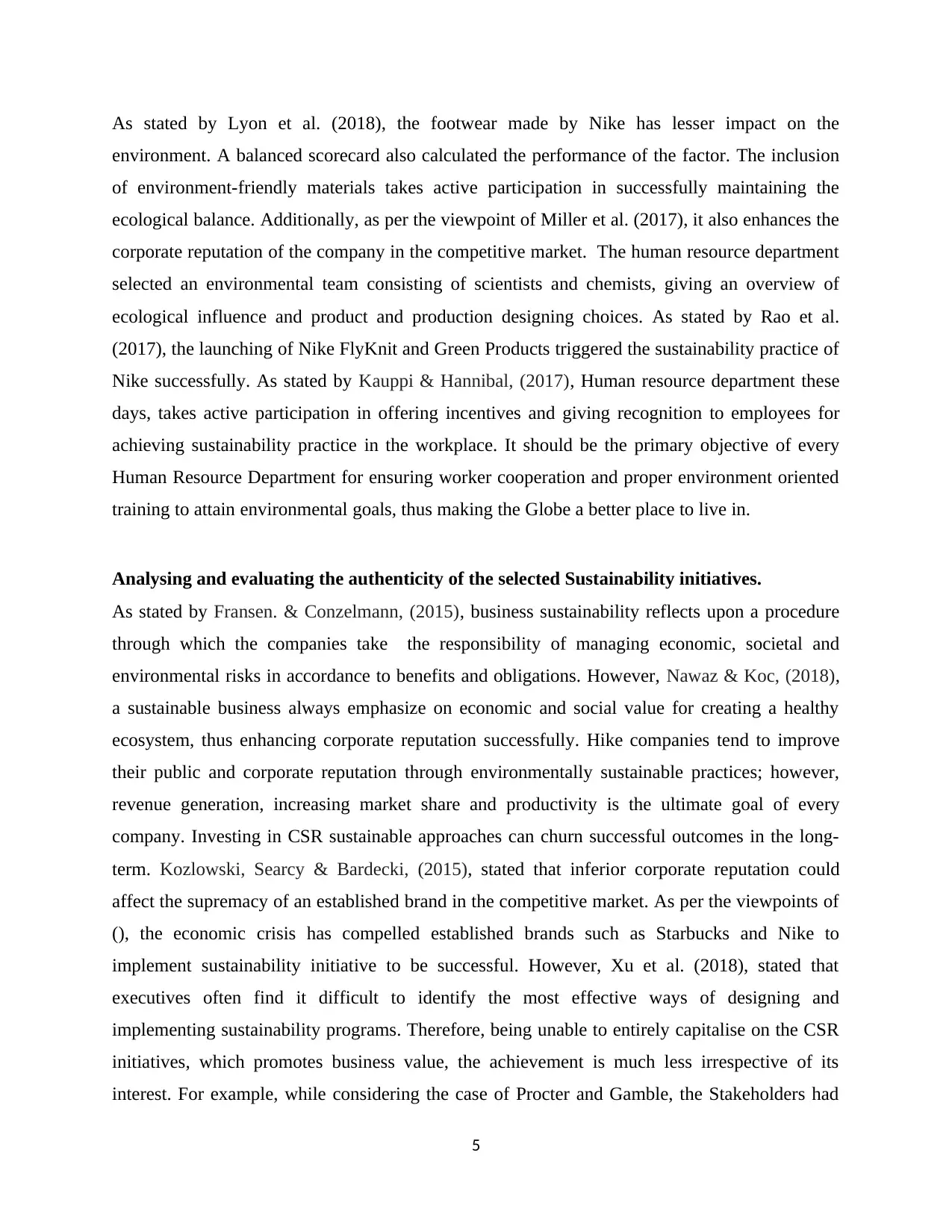
As stated by Lyon et al. (2018), the footwear made by Nike has lesser impact on the
environment. A balanced scorecard also calculated the performance of the factor. The inclusion
of environment-friendly materials takes active participation in successfully maintaining the
ecological balance. Additionally, as per the viewpoint of Miller et al. (2017), it also enhances the
corporate reputation of the company in the competitive market. The human resource department
selected an environmental team consisting of scientists and chemists, giving an overview of
ecological influence and product and production designing choices. As stated by Rao et al.
(2017), the launching of Nike FlyKnit and Green Products triggered the sustainability practice of
Nike successfully. As stated by Kauppi & Hannibal, (2017), Human resource department these
days, takes active participation in offering incentives and giving recognition to employees for
achieving sustainability practice in the workplace. It should be the primary objective of every
Human Resource Department for ensuring worker cooperation and proper environment oriented
training to attain environmental goals, thus making the Globe a better place to live in.
Analysing and evaluating the authenticity of the selected Sustainability initiatives.
As stated by Fransen. & Conzelmann, (2015), business sustainability reflects upon a procedure
through which the companies take the responsibility of managing economic, societal and
environmental risks in accordance to benefits and obligations. However, Nawaz & Koc, (2018),
a sustainable business always emphasize on economic and social value for creating a healthy
ecosystem, thus enhancing corporate reputation successfully. Hike companies tend to improve
their public and corporate reputation through environmentally sustainable practices; however,
revenue generation, increasing market share and productivity is the ultimate goal of every
company. Investing in CSR sustainable approaches can churn successful outcomes in the long-
term. Kozlowski, Searcy & Bardecki, (2015), stated that inferior corporate reputation could
affect the supremacy of an established brand in the competitive market. As per the viewpoints of
(), the economic crisis has compelled established brands such as Starbucks and Nike to
implement sustainability initiative to be successful. However, Xu et al. (2018), stated that
executives often find it difficult to identify the most effective ways of designing and
implementing sustainability programs. Therefore, being unable to entirely capitalise on the CSR
initiatives, which promotes business value, the achievement is much less irrespective of its
interest. For example, while considering the case of Procter and Gamble, the Stakeholders had
5
environment. A balanced scorecard also calculated the performance of the factor. The inclusion
of environment-friendly materials takes active participation in successfully maintaining the
ecological balance. Additionally, as per the viewpoint of Miller et al. (2017), it also enhances the
corporate reputation of the company in the competitive market. The human resource department
selected an environmental team consisting of scientists and chemists, giving an overview of
ecological influence and product and production designing choices. As stated by Rao et al.
(2017), the launching of Nike FlyKnit and Green Products triggered the sustainability practice of
Nike successfully. As stated by Kauppi & Hannibal, (2017), Human resource department these
days, takes active participation in offering incentives and giving recognition to employees for
achieving sustainability practice in the workplace. It should be the primary objective of every
Human Resource Department for ensuring worker cooperation and proper environment oriented
training to attain environmental goals, thus making the Globe a better place to live in.
Analysing and evaluating the authenticity of the selected Sustainability initiatives.
As stated by Fransen. & Conzelmann, (2015), business sustainability reflects upon a procedure
through which the companies take the responsibility of managing economic, societal and
environmental risks in accordance to benefits and obligations. However, Nawaz & Koc, (2018),
a sustainable business always emphasize on economic and social value for creating a healthy
ecosystem, thus enhancing corporate reputation successfully. Hike companies tend to improve
their public and corporate reputation through environmentally sustainable practices; however,
revenue generation, increasing market share and productivity is the ultimate goal of every
company. Investing in CSR sustainable approaches can churn successful outcomes in the long-
term. Kozlowski, Searcy & Bardecki, (2015), stated that inferior corporate reputation could
affect the supremacy of an established brand in the competitive market. As per the viewpoints of
(), the economic crisis has compelled established brands such as Starbucks and Nike to
implement sustainability initiative to be successful. However, Xu et al. (2018), stated that
executives often find it difficult to identify the most effective ways of designing and
implementing sustainability programs. Therefore, being unable to entirely capitalise on the CSR
initiatives, which promotes business value, the achievement is much less irrespective of its
interest. For example, while considering the case of Procter and Gamble, the Stakeholders had
5
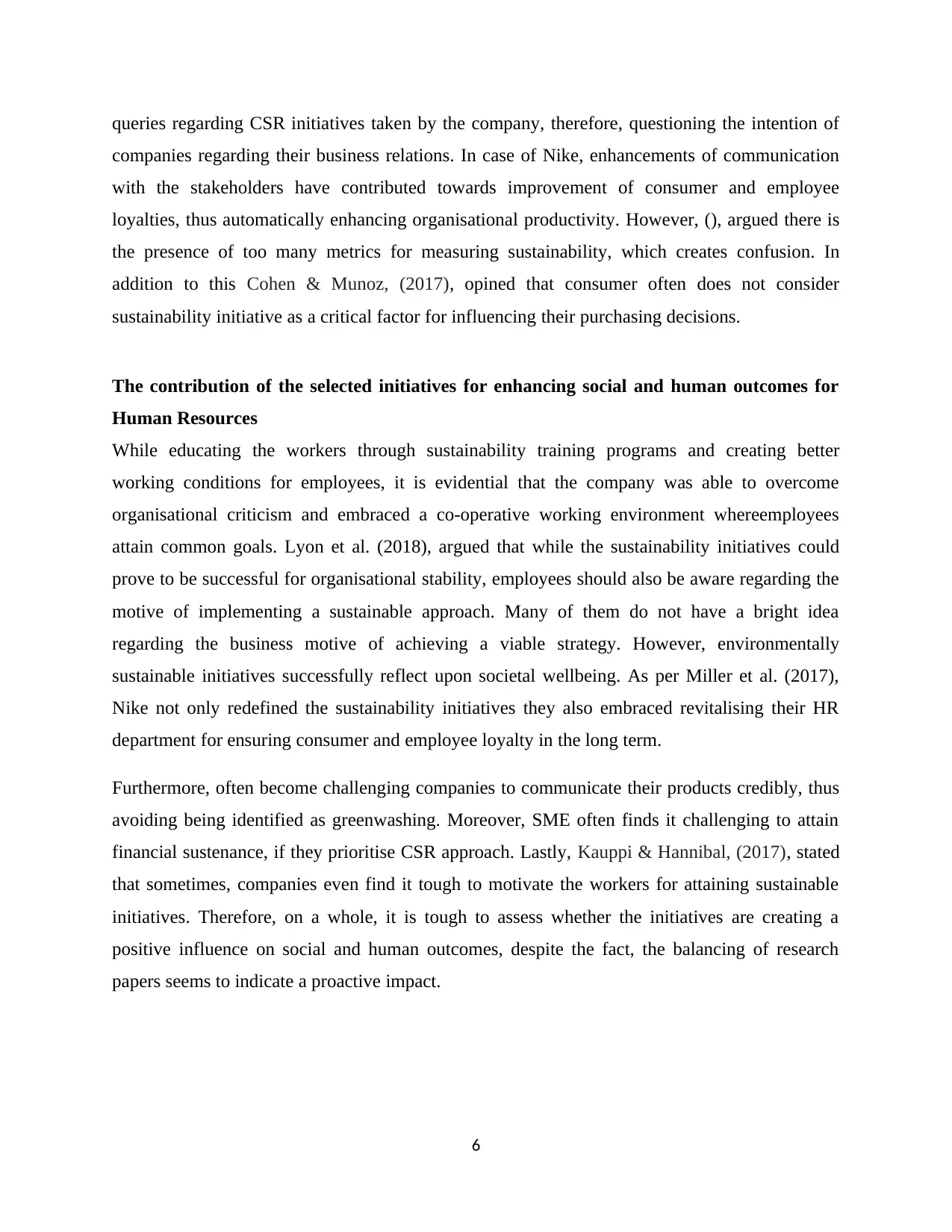
queries regarding CSR initiatives taken by the company, therefore, questioning the intention of
companies regarding their business relations. In case of Nike, enhancements of communication
with the stakeholders have contributed towards improvement of consumer and employee
loyalties, thus automatically enhancing organisational productivity. However, (), argued there is
the presence of too many metrics for measuring sustainability, which creates confusion. In
addition to this Cohen & Munoz, (2017), opined that consumer often does not consider
sustainability initiative as a critical factor for influencing their purchasing decisions.
The contribution of the selected initiatives for enhancing social and human outcomes for
Human Resources
While educating the workers through sustainability training programs and creating better
working conditions for employees, it is evidential that the company was able to overcome
organisational criticism and embraced a co-operative working environment whereemployees
attain common goals. Lyon et al. (2018), argued that while the sustainability initiatives could
prove to be successful for organisational stability, employees should also be aware regarding the
motive of implementing a sustainable approach. Many of them do not have a bright idea
regarding the business motive of achieving a viable strategy. However, environmentally
sustainable initiatives successfully reflect upon societal wellbeing. As per Miller et al. (2017),
Nike not only redefined the sustainability initiatives they also embraced revitalising their HR
department for ensuring consumer and employee loyalty in the long term.
Furthermore, often become challenging companies to communicate their products credibly, thus
avoiding being identified as greenwashing. Moreover, SME often finds it challenging to attain
financial sustenance, if they prioritise CSR approach. Lastly, Kauppi & Hannibal, (2017), stated
that sometimes, companies even find it tough to motivate the workers for attaining sustainable
initiatives. Therefore, on a whole, it is tough to assess whether the initiatives are creating a
positive influence on social and human outcomes, despite the fact, the balancing of research
papers seems to indicate a proactive impact.
6
companies regarding their business relations. In case of Nike, enhancements of communication
with the stakeholders have contributed towards improvement of consumer and employee
loyalties, thus automatically enhancing organisational productivity. However, (), argued there is
the presence of too many metrics for measuring sustainability, which creates confusion. In
addition to this Cohen & Munoz, (2017), opined that consumer often does not consider
sustainability initiative as a critical factor for influencing their purchasing decisions.
The contribution of the selected initiatives for enhancing social and human outcomes for
Human Resources
While educating the workers through sustainability training programs and creating better
working conditions for employees, it is evidential that the company was able to overcome
organisational criticism and embraced a co-operative working environment whereemployees
attain common goals. Lyon et al. (2018), argued that while the sustainability initiatives could
prove to be successful for organisational stability, employees should also be aware regarding the
motive of implementing a sustainable approach. Many of them do not have a bright idea
regarding the business motive of achieving a viable strategy. However, environmentally
sustainable initiatives successfully reflect upon societal wellbeing. As per Miller et al. (2017),
Nike not only redefined the sustainability initiatives they also embraced revitalising their HR
department for ensuring consumer and employee loyalty in the long term.
Furthermore, often become challenging companies to communicate their products credibly, thus
avoiding being identified as greenwashing. Moreover, SME often finds it challenging to attain
financial sustenance, if they prioritise CSR approach. Lastly, Kauppi & Hannibal, (2017), stated
that sometimes, companies even find it tough to motivate the workers for attaining sustainable
initiatives. Therefore, on a whole, it is tough to assess whether the initiatives are creating a
positive influence on social and human outcomes, despite the fact, the balancing of research
papers seems to indicate a proactive impact.
6
⊘ This is a preview!⊘
Do you want full access?
Subscribe today to unlock all pages.

Trusted by 1+ million students worldwide
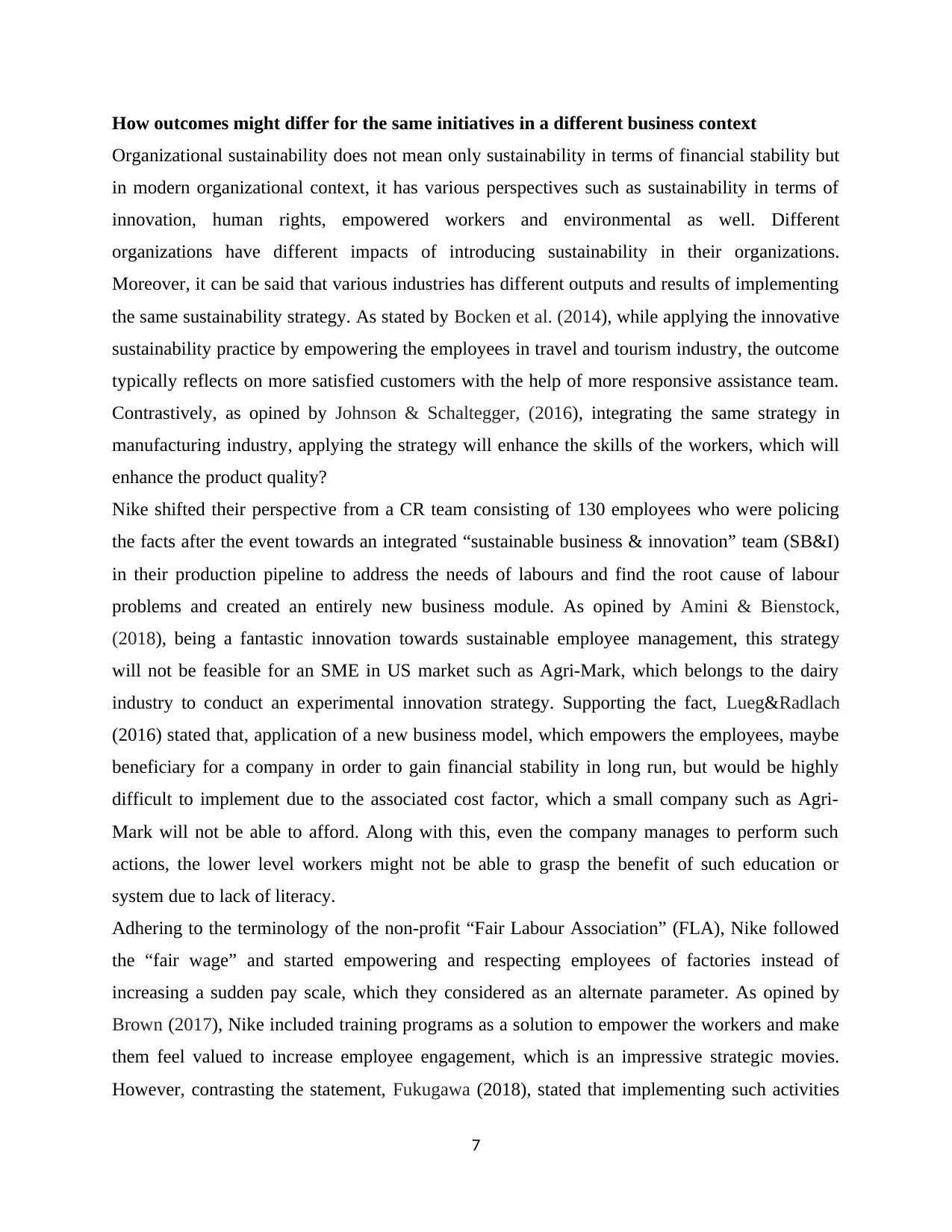
How outcomes might differ for the same initiatives in a different business context
Organizational sustainability does not mean only sustainability in terms of financial stability but
in modern organizational context, it has various perspectives such as sustainability in terms of
innovation, human rights, empowered workers and environmental as well. Different
organizations have different impacts of introducing sustainability in their organizations.
Moreover, it can be said that various industries has different outputs and results of implementing
the same sustainability strategy. As stated by Bocken et al. (2014), while applying the innovative
sustainability practice by empowering the employees in travel and tourism industry, the outcome
typically reflects on more satisfied customers with the help of more responsive assistance team.
Contrastively, as opined by Johnson & Schaltegger, (2016), integrating the same strategy in
manufacturing industry, applying the strategy will enhance the skills of the workers, which will
enhance the product quality?
Nike shifted their perspective from a CR team consisting of 130 employees who were policing
the facts after the event towards an integrated “sustainable business & innovation” team (SB&I)
in their production pipeline to address the needs of labours and find the root cause of labour
problems and created an entirely new business module. As opined by Amini & Bienstock,
(2018), being a fantastic innovation towards sustainable employee management, this strategy
will not be feasible for an SME in US market such as Agri-Mark, which belongs to the dairy
industry to conduct an experimental innovation strategy. Supporting the fact, Lueg&Radlach
(2016) stated that, application of a new business model, which empowers the employees, maybe
beneficiary for a company in order to gain financial stability in long run, but would be highly
difficult to implement due to the associated cost factor, which a small company such as Agri-
Mark will not be able to afford. Along with this, even the company manages to perform such
actions, the lower level workers might not be able to grasp the benefit of such education or
system due to lack of literacy.
Adhering to the terminology of the non-profit “Fair Labour Association” (FLA), Nike followed
the “fair wage” and started empowering and respecting employees of factories instead of
increasing a sudden pay scale, which they considered as an alternate parameter. As opined by
Brown (2017), Nike included training programs as a solution to empower the workers and make
them feel valued to increase employee engagement, which is an impressive strategic movies.
However, contrasting the statement, Fukugawa (2018), stated that implementing such activities
7
Organizational sustainability does not mean only sustainability in terms of financial stability but
in modern organizational context, it has various perspectives such as sustainability in terms of
innovation, human rights, empowered workers and environmental as well. Different
organizations have different impacts of introducing sustainability in their organizations.
Moreover, it can be said that various industries has different outputs and results of implementing
the same sustainability strategy. As stated by Bocken et al. (2014), while applying the innovative
sustainability practice by empowering the employees in travel and tourism industry, the outcome
typically reflects on more satisfied customers with the help of more responsive assistance team.
Contrastively, as opined by Johnson & Schaltegger, (2016), integrating the same strategy in
manufacturing industry, applying the strategy will enhance the skills of the workers, which will
enhance the product quality?
Nike shifted their perspective from a CR team consisting of 130 employees who were policing
the facts after the event towards an integrated “sustainable business & innovation” team (SB&I)
in their production pipeline to address the needs of labours and find the root cause of labour
problems and created an entirely new business module. As opined by Amini & Bienstock,
(2018), being a fantastic innovation towards sustainable employee management, this strategy
will not be feasible for an SME in US market such as Agri-Mark, which belongs to the dairy
industry to conduct an experimental innovation strategy. Supporting the fact, Lueg&Radlach
(2016) stated that, application of a new business model, which empowers the employees, maybe
beneficiary for a company in order to gain financial stability in long run, but would be highly
difficult to implement due to the associated cost factor, which a small company such as Agri-
Mark will not be able to afford. Along with this, even the company manages to perform such
actions, the lower level workers might not be able to grasp the benefit of such education or
system due to lack of literacy.
Adhering to the terminology of the non-profit “Fair Labour Association” (FLA), Nike followed
the “fair wage” and started empowering and respecting employees of factories instead of
increasing a sudden pay scale, which they considered as an alternate parameter. As opined by
Brown (2017), Nike included training programs as a solution to empower the workers and make
them feel valued to increase employee engagement, which is an impressive strategic movies.
However, contrasting the statement, Fukugawa (2018), stated that implementing such activities
7
Paraphrase This Document
Need a fresh take? Get an instant paraphrase of this document with our AI Paraphraser
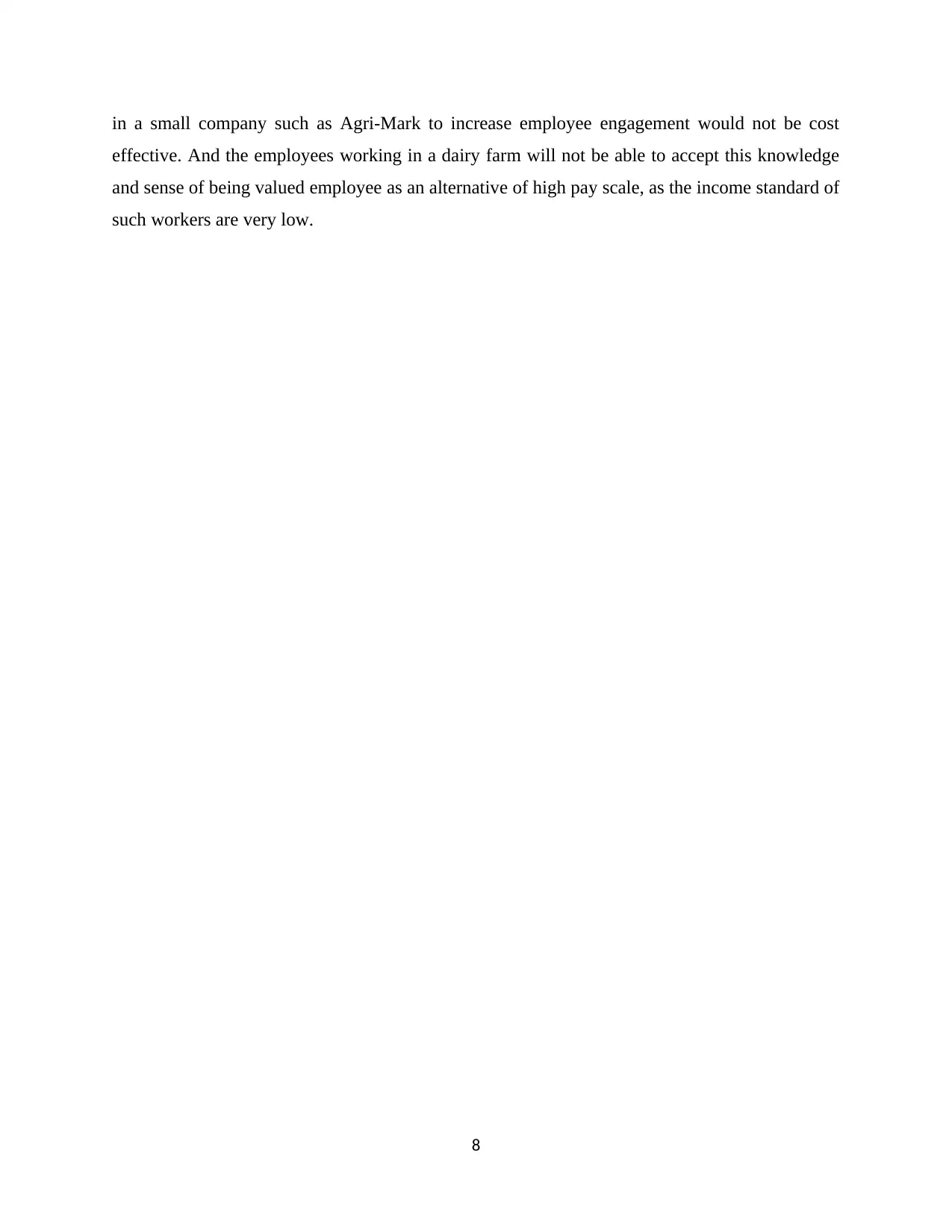
in a small company such as Agri-Mark to increase employee engagement would not be cost
effective. And the employees working in a dairy farm will not be able to accept this knowledge
and sense of being valued employee as an alternative of high pay scale, as the income standard of
such workers are very low.
8
effective. And the employees working in a dairy farm will not be able to accept this knowledge
and sense of being valued employee as an alternative of high pay scale, as the income standard of
such workers are very low.
8
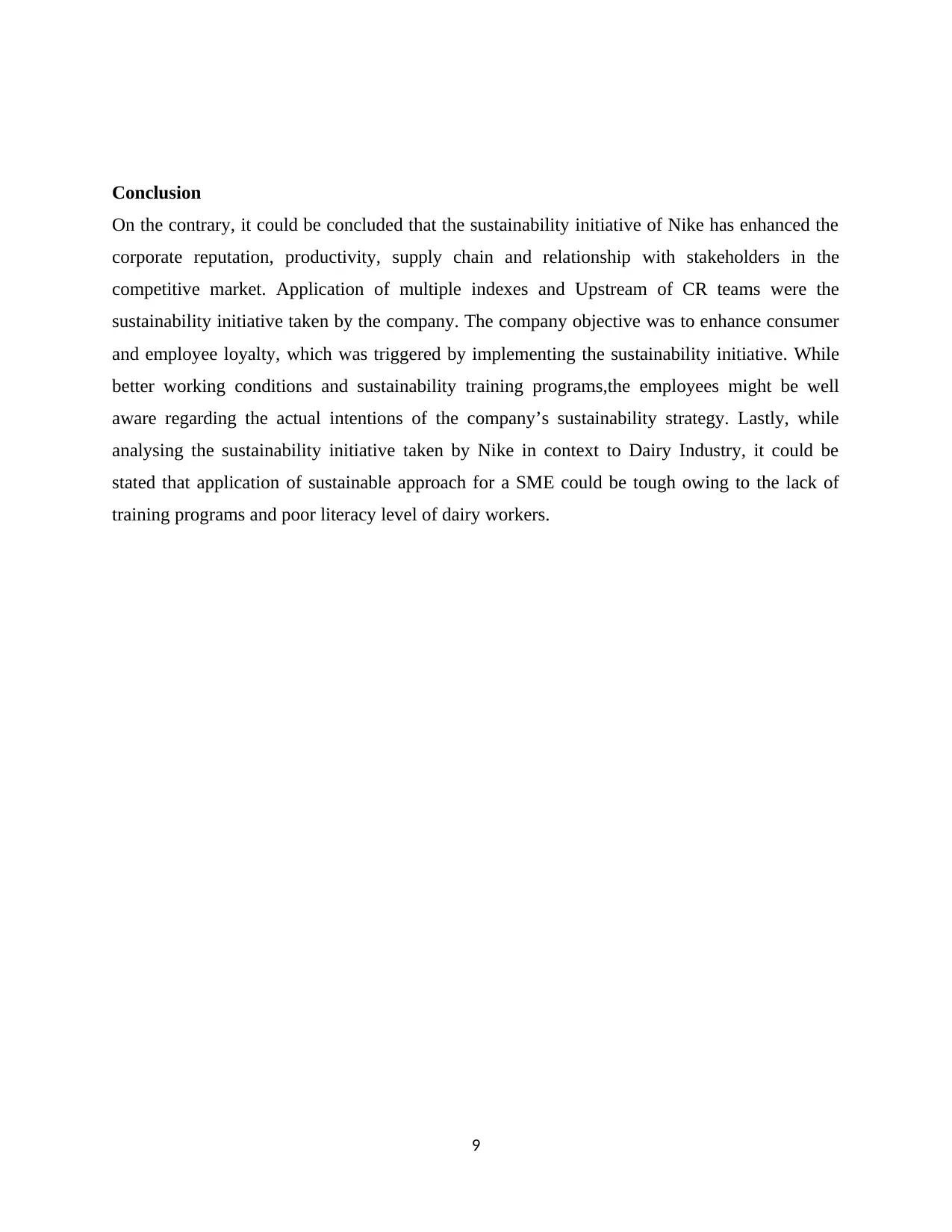
Conclusion
On the contrary, it could be concluded that the sustainability initiative of Nike has enhanced the
corporate reputation, productivity, supply chain and relationship with stakeholders in the
competitive market. Application of multiple indexes and Upstream of CR teams were the
sustainability initiative taken by the company. The company objective was to enhance consumer
and employee loyalty, which was triggered by implementing the sustainability initiative. While
better working conditions and sustainability training programs,the employees might be well
aware regarding the actual intentions of the company’s sustainability strategy. Lastly, while
analysing the sustainability initiative taken by Nike in context to Dairy Industry, it could be
stated that application of sustainable approach for a SME could be tough owing to the lack of
training programs and poor literacy level of dairy workers.
9
On the contrary, it could be concluded that the sustainability initiative of Nike has enhanced the
corporate reputation, productivity, supply chain and relationship with stakeholders in the
competitive market. Application of multiple indexes and Upstream of CR teams were the
sustainability initiative taken by the company. The company objective was to enhance consumer
and employee loyalty, which was triggered by implementing the sustainability initiative. While
better working conditions and sustainability training programs,the employees might be well
aware regarding the actual intentions of the company’s sustainability strategy. Lastly, while
analysing the sustainability initiative taken by Nike in context to Dairy Industry, it could be
stated that application of sustainable approach for a SME could be tough owing to the lack of
training programs and poor literacy level of dairy workers.
9
⊘ This is a preview!⊘
Do you want full access?
Subscribe today to unlock all pages.

Trusted by 1+ million students worldwide
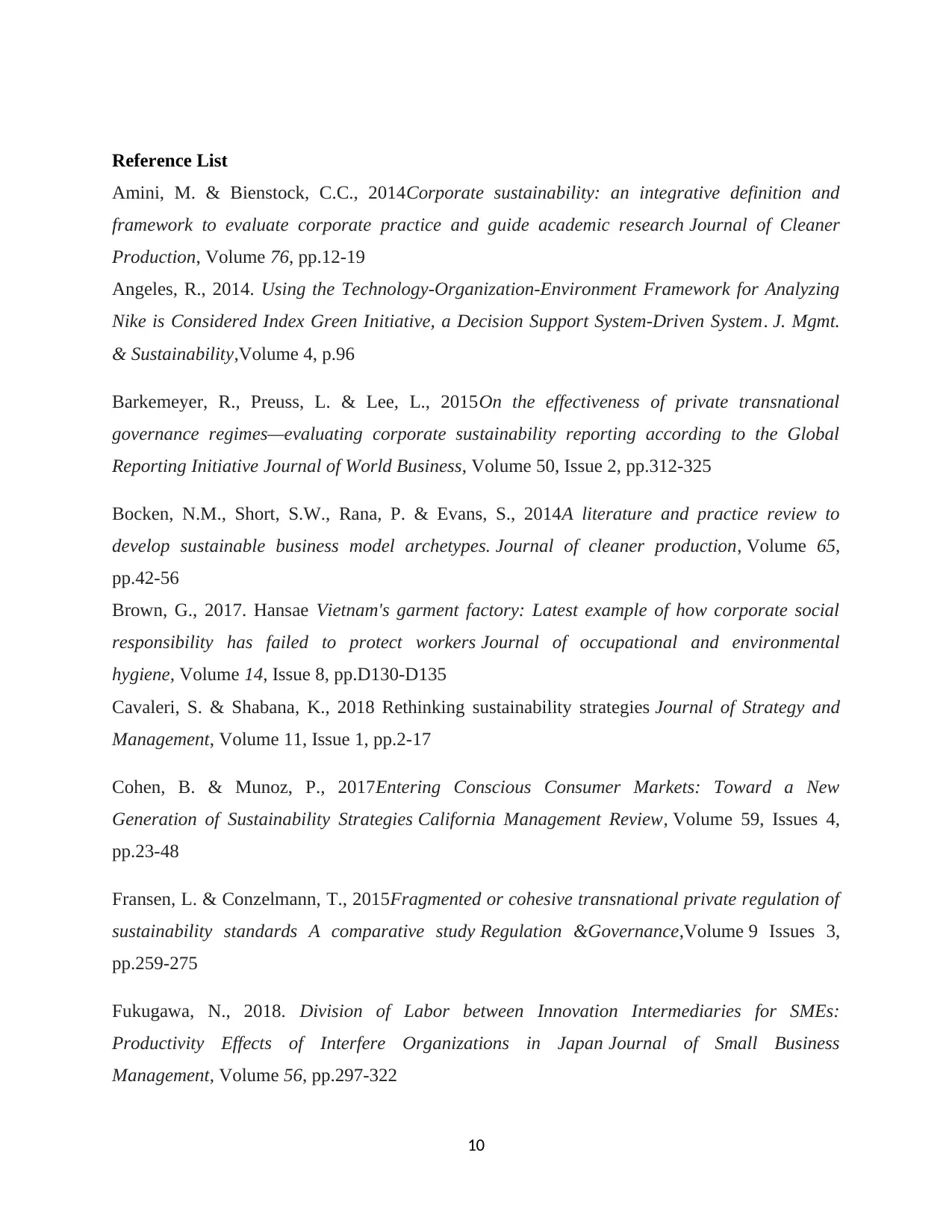
Reference List
Amini, M. & Bienstock, C.C., 2014Corporate sustainability: an integrative definition and
framework to evaluate corporate practice and guide academic research Journal of Cleaner
Production, Volume 76, pp.12-19
Angeles, R., 2014. Using the Technology-Organization-Environment Framework for Analyzing
Nike is Considered Index Green Initiative, a Decision Support System-Driven System. J. Mgmt.
& Sustainability,Volume 4, p.96
Barkemeyer, R., Preuss, L. & Lee, L., 2015On the effectiveness of private transnational
governance regimes—evaluating corporate sustainability reporting according to the Global
Reporting Initiative Journal of World Business, Volume 50, Issue 2, pp.312-325
Bocken, N.M., Short, S.W., Rana, P. & Evans, S., 2014A literature and practice review to
develop sustainable business model archetypes. Journal of cleaner production, Volume 65,
pp.42-56
Brown, G., 2017. Hansae Vietnam's garment factory: Latest example of how corporate social
responsibility has failed to protect workers Journal of occupational and environmental
hygiene, Volume 14, Issue 8, pp.D130-D135
Cavaleri, S. & Shabana, K., 2018 Rethinking sustainability strategies Journal of Strategy and
Management, Volume 11, Issue 1, pp.2-17
Cohen, B. & Munoz, P., 2017Entering Conscious Consumer Markets: Toward a New
Generation of Sustainability Strategies California Management Review, Volume 59, Issues 4,
pp.23-48
Fransen, L. & Conzelmann, T., 2015Fragmented or cohesive transnational private regulation of
sustainability standards A comparative study Regulation &Governance,Volume 9 Issues 3,
pp.259-275
Fukugawa, N., 2018. Division of Labor between Innovation Intermediaries for SMEs:
Productivity Effects of Interfere Organizations in Japan Journal of Small Business
Management, Volume 56, pp.297-322
10
Amini, M. & Bienstock, C.C., 2014Corporate sustainability: an integrative definition and
framework to evaluate corporate practice and guide academic research Journal of Cleaner
Production, Volume 76, pp.12-19
Angeles, R., 2014. Using the Technology-Organization-Environment Framework for Analyzing
Nike is Considered Index Green Initiative, a Decision Support System-Driven System. J. Mgmt.
& Sustainability,Volume 4, p.96
Barkemeyer, R., Preuss, L. & Lee, L., 2015On the effectiveness of private transnational
governance regimes—evaluating corporate sustainability reporting according to the Global
Reporting Initiative Journal of World Business, Volume 50, Issue 2, pp.312-325
Bocken, N.M., Short, S.W., Rana, P. & Evans, S., 2014A literature and practice review to
develop sustainable business model archetypes. Journal of cleaner production, Volume 65,
pp.42-56
Brown, G., 2017. Hansae Vietnam's garment factory: Latest example of how corporate social
responsibility has failed to protect workers Journal of occupational and environmental
hygiene, Volume 14, Issue 8, pp.D130-D135
Cavaleri, S. & Shabana, K., 2018 Rethinking sustainability strategies Journal of Strategy and
Management, Volume 11, Issue 1, pp.2-17
Cohen, B. & Munoz, P., 2017Entering Conscious Consumer Markets: Toward a New
Generation of Sustainability Strategies California Management Review, Volume 59, Issues 4,
pp.23-48
Fransen, L. & Conzelmann, T., 2015Fragmented or cohesive transnational private regulation of
sustainability standards A comparative study Regulation &Governance,Volume 9 Issues 3,
pp.259-275
Fukugawa, N., 2018. Division of Labor between Innovation Intermediaries for SMEs:
Productivity Effects of Interfere Organizations in Japan Journal of Small Business
Management, Volume 56, pp.297-322
10
Paraphrase This Document
Need a fresh take? Get an instant paraphrase of this document with our AI Paraphraser
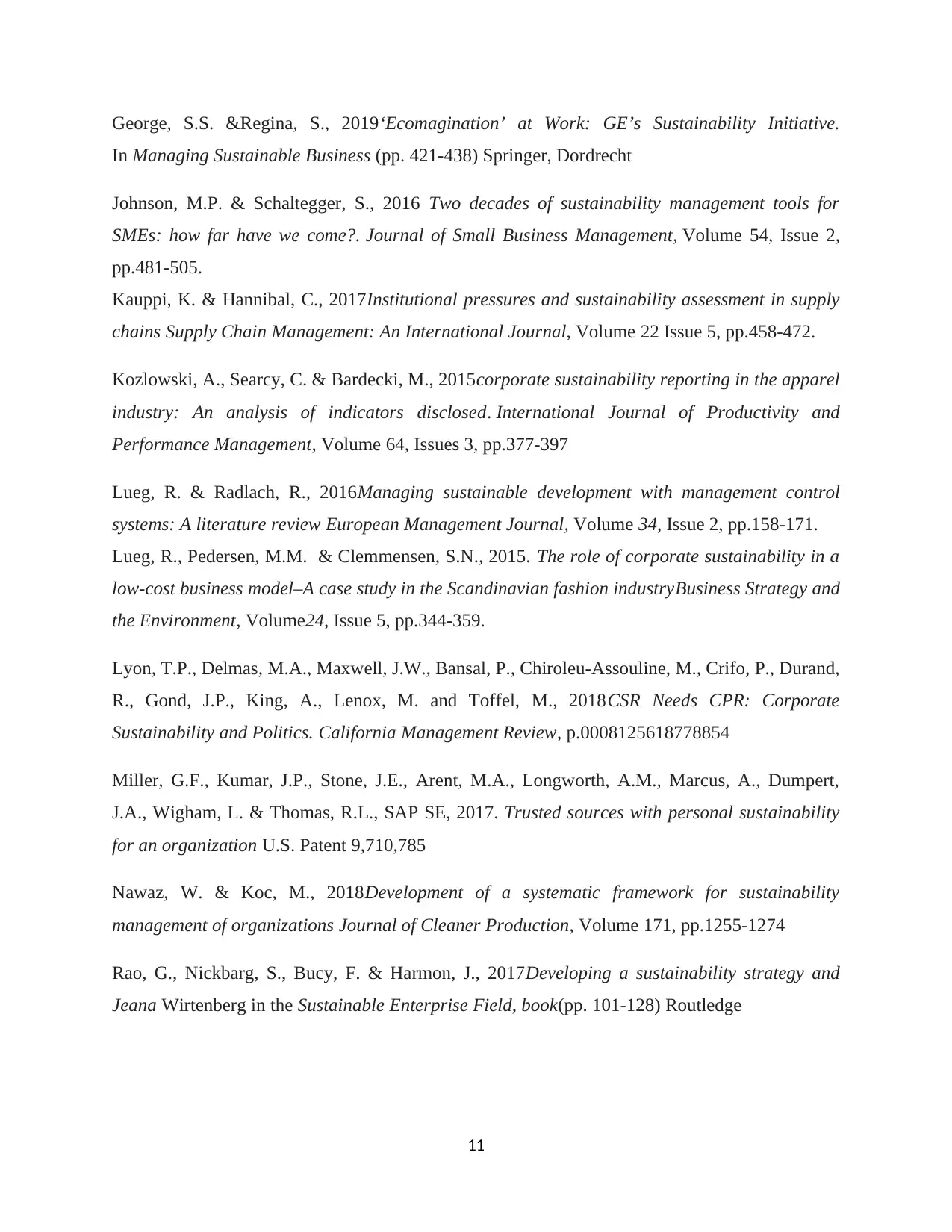
George, S.S. &Regina, S., 2019‘Ecomagination’ at Work: GE’s Sustainability Initiative.
In Managing Sustainable Business (pp. 421-438) Springer, Dordrecht
Johnson, M.P. & Schaltegger, S., 2016 Two decades of sustainability management tools for
SMEs: how far have we come?. Journal of Small Business Management, Volume 54, Issue 2,
pp.481-505.
Kauppi, K. & Hannibal, C., 2017Institutional pressures and sustainability assessment in supply
chains Supply Chain Management: An International Journal, Volume 22 Issue 5, pp.458-472.
Kozlowski, A., Searcy, C. & Bardecki, M., 2015corporate sustainability reporting in the apparel
industry: An analysis of indicators disclosed. International Journal of Productivity and
Performance Management, Volume 64, Issues 3, pp.377-397
Lueg, R. & Radlach, R., 2016Managing sustainable development with management control
systems: A literature review European Management Journal, Volume 34, Issue 2, pp.158-171.
Lueg, R., Pedersen, M.M. & Clemmensen, S.N., 2015. The role of corporate sustainability in a
low‐cost business model–A case study in the Scandinavian fashion industryBusiness Strategy and
the Environment, Volume24, Issue 5, pp.344-359.
Lyon, T.P., Delmas, M.A., Maxwell, J.W., Bansal, P., Chiroleu-Assouline, M., Crifo, P., Durand,
R., Gond, J.P., King, A., Lenox, M. and Toffel, M., 2018CSR Needs CPR: Corporate
Sustainability and Politics. California Management Review, p.0008125618778854
Miller, G.F., Kumar, J.P., Stone, J.E., Arent, M.A., Longworth, A.M., Marcus, A., Dumpert,
J.A., Wigham, L. & Thomas, R.L., SAP SE, 2017. Trusted sources with personal sustainability
for an organization U.S. Patent 9,710,785
Nawaz, W. & Koc, M., 2018Development of a systematic framework for sustainability
management of organizations Journal of Cleaner Production, Volume 171, pp.1255-1274
Rao, G., Nickbarg, S., Bucy, F. & Harmon, J., 2017Developing a sustainability strategy and
Jeana Wirtenberg in the Sustainable Enterprise Field, book(pp. 101-128) Routledge
11
In Managing Sustainable Business (pp. 421-438) Springer, Dordrecht
Johnson, M.P. & Schaltegger, S., 2016 Two decades of sustainability management tools for
SMEs: how far have we come?. Journal of Small Business Management, Volume 54, Issue 2,
pp.481-505.
Kauppi, K. & Hannibal, C., 2017Institutional pressures and sustainability assessment in supply
chains Supply Chain Management: An International Journal, Volume 22 Issue 5, pp.458-472.
Kozlowski, A., Searcy, C. & Bardecki, M., 2015corporate sustainability reporting in the apparel
industry: An analysis of indicators disclosed. International Journal of Productivity and
Performance Management, Volume 64, Issues 3, pp.377-397
Lueg, R. & Radlach, R., 2016Managing sustainable development with management control
systems: A literature review European Management Journal, Volume 34, Issue 2, pp.158-171.
Lueg, R., Pedersen, M.M. & Clemmensen, S.N., 2015. The role of corporate sustainability in a
low‐cost business model–A case study in the Scandinavian fashion industryBusiness Strategy and
the Environment, Volume24, Issue 5, pp.344-359.
Lyon, T.P., Delmas, M.A., Maxwell, J.W., Bansal, P., Chiroleu-Assouline, M., Crifo, P., Durand,
R., Gond, J.P., King, A., Lenox, M. and Toffel, M., 2018CSR Needs CPR: Corporate
Sustainability and Politics. California Management Review, p.0008125618778854
Miller, G.F., Kumar, J.P., Stone, J.E., Arent, M.A., Longworth, A.M., Marcus, A., Dumpert,
J.A., Wigham, L. & Thomas, R.L., SAP SE, 2017. Trusted sources with personal sustainability
for an organization U.S. Patent 9,710,785
Nawaz, W. & Koc, M., 2018Development of a systematic framework for sustainability
management of organizations Journal of Cleaner Production, Volume 171, pp.1255-1274
Rao, G., Nickbarg, S., Bucy, F. & Harmon, J., 2017Developing a sustainability strategy and
Jeana Wirtenberg in the Sustainable Enterprise Field, book(pp. 101-128) Routledge
11
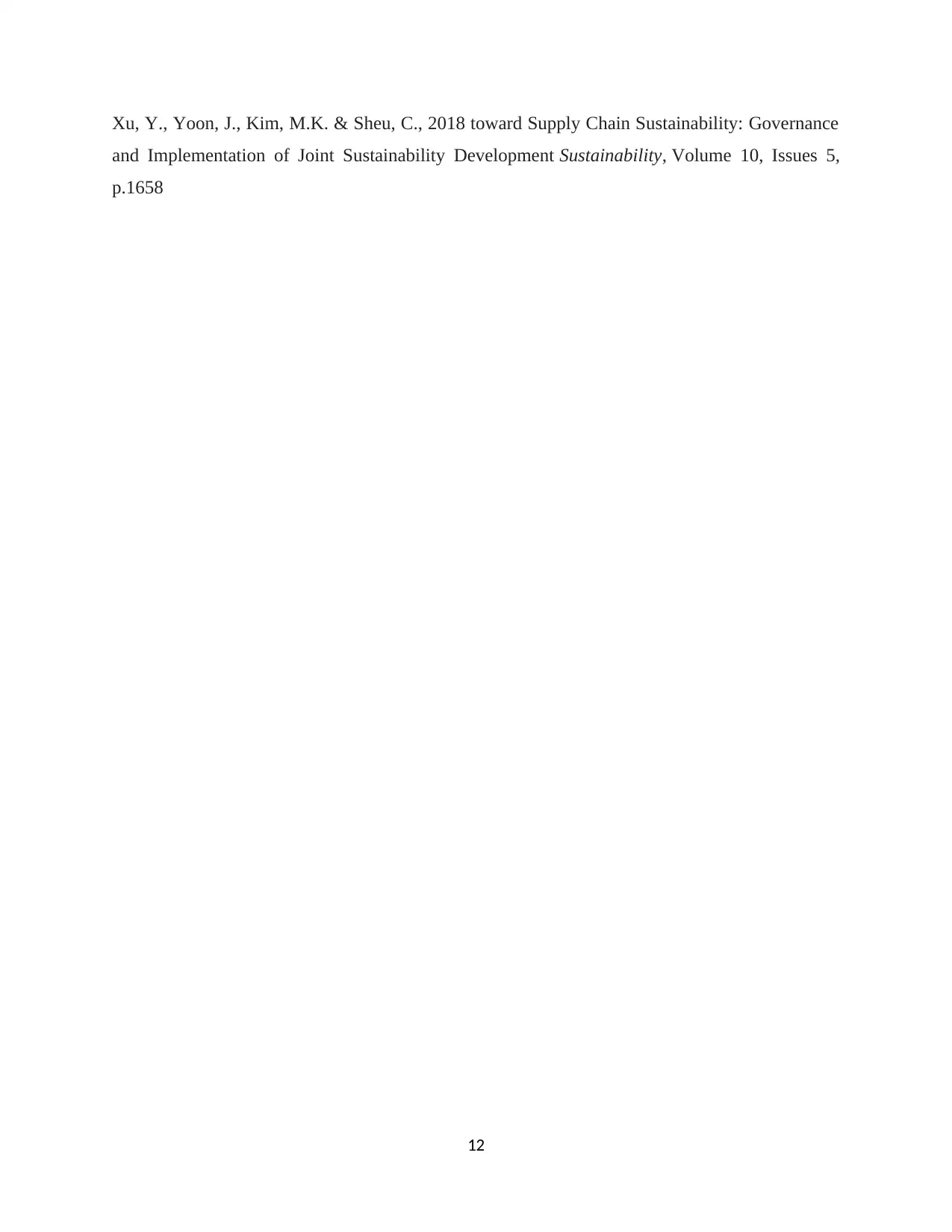
Xu, Y., Yoon, J., Kim, M.K. & Sheu, C., 2018 toward Supply Chain Sustainability: Governance
and Implementation of Joint Sustainability Development Sustainability, Volume 10, Issues 5,
p.1658
12
and Implementation of Joint Sustainability Development Sustainability, Volume 10, Issues 5,
p.1658
12
⊘ This is a preview!⊘
Do you want full access?
Subscribe today to unlock all pages.

Trusted by 1+ million students worldwide
1 out of 12
Related Documents
Your All-in-One AI-Powered Toolkit for Academic Success.
+13062052269
info@desklib.com
Available 24*7 on WhatsApp / Email
![[object Object]](/_next/static/media/star-bottom.7253800d.svg)
Unlock your academic potential
Copyright © 2020–2025 A2Z Services. All Rights Reserved. Developed and managed by ZUCOL.




